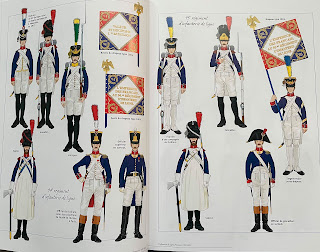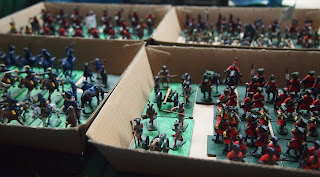It's great how a theme is picked up and passed from one blogger to another. Things like the painting challenge, the figure advent calendar and this one: influential books.
Back on 11th December, Nundanket at Horse and Musket Gaming made a most interesting post about books that had been influential in his getting into the hobby. Iain of caveadsum1471 followed suit with a post about a splendid tome, 'Military Uniforms: The Splendour of the Past' that had been an early inspiration for him, as well as images of his fantastic looking library. Matt of wargamesinthedungeon went to do the same but, realising that he'd done one already about that for his 500th post, re-publised that, along with some of his library!
Reading, collecting and admiring books is a huge part of the enjoyment of the hobby for me. I have even mused that, if forced to one of those 'choose your favourite pet' kind of choices, I would take the books over the figures. So, here's my little bit of input of influential books, favourites in the library and a quick review of a newie.
Influential books
For me the most influential books have to come down to the duo du Garde Peach's Story of Napoleon and Bruce Quarrie's Napoleonic Wargaming. The former took me down the path of an interest in Napoleon and all things napoleonic and the latter was the first book about wargaming that I owned/read and the first rules that Dad and I played. They have both been eclipsed since, many times over, but they remain special to me and I still remember how I enjoyed reading them and pawing over them as a boy.
I had numerous volumes in Ladybird's Adventure from History series, but none grabbed me quite like the Story of Napoleon. Add to this some sets of Airfix Napoleonic figures and I was on my way. Actually, I considered making dioramas rather than wargames. The idea of wargaming came from a suggestion from my dad and the purchase of Quarrie's guidebook and rules followed.
Quarrie's rules may have had numerous glitches, but his practical guide, suggestions, descriptions and photos were a fabulous source of inspiration to me. I longed to have sufficient figures painted so that we could play our first game. It took about four years to happen, but a life-long hobby/obsession was born.
Favourite books
Fast-forward some 47 years from du Garde Peach, or 40-odd since the first wargame, and the shackles are well and truly off! The home library has steadily increased over those years, particularly the past 20 and especially the last ten or so. I have been taking advantage of the fact that books (like figures) are cheaper than they were back then, in relative terms, plus a greater ability with age to invest in the hobby. In fact so 'crazy' have I gone in recent years that now even I consider that I have enough and am limiting myself to only a few, specific and/or really special additions.
 |
| One bookcase for 'periods other than Napoleonic'. |
 |
| Main bookcase of Napoleonic books, organised from general history/biography then chronologically. |
 |
| Smaller bookcases carrying on the chronology. |
 |
| Some small bookcases with assorted periods and most of my wargaming rules. |
I enjoy all the books that I have but, if forced to choose my favourites, it would come down to The Anatomy of Glory (a reprint of which I reviewed last year) and two series of books about Napoleonic uniforms: those by Eugène-Louis Bucquoy and Guy Devautour and the 'splendeur' series by G. Charmy.
 |
| A simple bookcase that I made recently to hold my now most prized books: about uniforms, especially Napoleonic. |
Brief review of a newie—L'infanterie de ligne 1814-1845
Having greatly enjoyed the first volume of Jouineau and Mongin's book on French infantry of the line (reviewed here), I immediately pre-ordered the second. I was not disappointed.
The second volume has all the features that I enjoyed in the first: pages and pages of colour plates illustrating different types of infantry (privates, NCOs, musicians, ensigns, officers) and uniforms from several regiments, detailed plates of items of uniform and equipment, descriptive text in easy-to-comprehend French (for my intermediate level) and numerous reprints of uniform plates, photographs of extant items of uniform and other illustrations of troops.

Above and below, examples of the pages illustrating different uniforms of troops types and various non-regulation examples.
 |
| A sample of one of the many pages illustrating items of uniform of the Bardin regulations. |
 |
| Plates showing examples of troops/uniforms or extant uniform items are also dotted throughout the book. |
The text begins with a description of the uniforms of officers from the mid-empire to the 1812 Bardin regulations. The second chapter describes the Bardin regulations in detail, regarding both uniform and equipment, with copious illustrations of each.
 |
| A sample page of uniforms of the second restoration (above) and July monarchy (below) |
Highly recommended: eight Napoleons
Back to the quasquibicentennial
The quasquibicentennial (a largely made-up latinised term for the 225th anniversary) of 1796 approaches rapidly!
I have not painted Napoleonic (revolutionary) figures for some two weeks or so, having decided, in an about-turn, to finish off First World War French and Germans first. Now, with these completed, it is back to Napoleonic figures.

Vistula legion, Frankfort am Main infantry and assorted others that are ready for the final stages of painting
I'll complete some of those that have been waiting for final touches since earlier in the year and apply my usual approach of continuing the use of a colour to bring infantry of the Armée d'Italie to completion.
References
Bucquoy,
E-L and Devautour, G (1977) La Garde Impérial: Troupes à Pied. Tome 1.
Les Uniformes du premier Empire J. Grancher, Paris, France.
Bucquoy, E-L and Devautour, G (1977) La Garde Impériale Troupes à cheval. Tome 2. Les Uniformes du premier Empire J. Grancher, Paris, France. 210 pp.
Bucquoy, E-L and Devautour, G (1979) Les Cuirassiers. Tome 3. Les Uniformes du premier Empire J. Grancher, Paris, France. 189 pp.
Bucquoy, E-L and Devautour, G (1980) L’Infanterie : L'infanterie de ligne et l'infanterie légère. Tome 4. Les Uniformes du premier Empire J. Grancher, Paris, France. 189 pp.
Bucquoy, En-L and Devautour, G (1980) La Cavalerie légère : les hussards, les chasseurs à cheval. Tome 5. Les Uniformes du premier Empire J. Grancher, Paris, France. 189 pp.
Bucquoy, E-L and Devautour, G (1980) Dragons et Guides. Tome 6. Les Uniformes du premier Empire J. Grancher, Paris, France. 189 pp.
Bucquoy, E-L and Devautour, G (1980) Etat-major et service de santé. Tome 7. Les Uniformes du premier Empire J. Grancher, Paris, France. 134 pp.
Bucquoy, E-L and Devautour, G (1977) Gardes D’Honneur et Troupes Etrangers. Tome 8. Les Uniformes du premier Empire J. Grancher, Paris, France. 205 pp.
Bucquoy, E-L and Devautour, G (1977) La Maison de l’Empereur. Tome 9. Les Uniformes du premier Empire J. Grancher, Paris, France. 123 pp.
Bucquoy, E-L and Devautour, G (1985) Fanfares et Musiques des troups à cheval 1640 - 1940. Tome 10. Les Uniformes du premier Empire J. Grancher, Paris, France. 126 pp. Location: Fisher collection, York.
Charmy, G (2002) Splendeur des Uniformes de Napoleon: Cavalerie. Tome 1. Editions Charles Herissey, Rennes, France. 326 pp.
Charmy,
G (2003) Splendeur des Uniformes de Napoleon: La Garde Imperiale à
Pied. Tome 2. Éditions Charles Hérissey, Évreux, France. 234 pp.
Charmy, G (2003) Splendeur des Uniformes de Napoleon: La Garde Imperiale à Cheval. Tome 3. Editions Charles Herissey, Rennes, France. 251 pp.
Charmy, G (2004) Splendeur des Uniformes de Napoleon: Infanterie et Regiments Etrangers. Tome 4. Editions Charles Herissey, Rennes, France. 285 pp.
Charmy, G (2004) Splendeur Des Uniformes de Napoleon: Costumes Du Sacre-Armes Drapeaux Et Decorations. Tome 5. Editions Charles Herissey, Rennes, France. 269 pp.
Charmy, G (2005) Splendeur des Uniformes de Napoleon: Marine-Gendarmerie-Artillerie-Génie-Gardes-Ecoles. Tome 6. Editions Charles Herissey, Rennes, France. 288 pp.
du Garde Peach, L and Kenney, J (1968) The Story of Napoleon. Adventure from History Ladybird Books Ltd, Loughborough, England. 51 pp.
Jouineau, A and Mongin, J-M (2020) L'infanterie de ligne 1814-1845. Tome 2. Éditions Heimdal, St Martin-des-Entrées, Bayeux, France. 160 pp.
Lachouque, H and Brown, ASK (1978) The Anatomy of Glory. Arms and Armour Press, London, England. 564 pp.
Quarrie, B (1974) Napoleonic Wargaming. Airfix magazine guide 4 Patrick Stephens Ltd, Cambridge, UK. 64 pp. Location: Fisher collection, York.















































